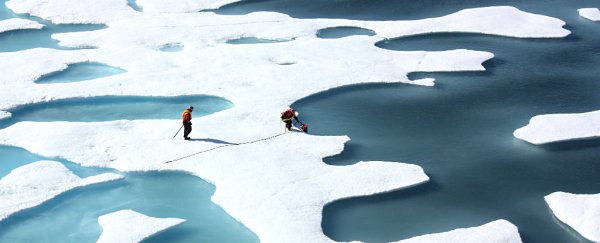The 2016 melt season in the Arctic Ocean has kicked off with a bang, with NASA reporting a record low peak for sea ice in March - for the second year running - followed by rapid rates of decline in May.
The good news is the melt has since slowed down, so we probably aren't going to set any more records this year. But the bad news is what would have been considered "extreme" just 10 years ago is now so commonplace, NASA's had to shift the baseline.
"A decade ago, this year's sea ice extent would have set a new record low and by a fair amount," says Walt Meier, a sea ice scientist at NASA's Goddard Space Flight Centre. "Now, we're kind of used to these low levels of sea ice - it's the new normal."
Scientists are now tasked with finding a new way to accurately measure this decline, because not only is the region showing no signs of improvement, we need to know just how bad things can get.
"Even when it's likely that we won't have a record low, the sea ice is not showing any kind of recovery," says Meier. "It's still in a continued decline over the long term."
Back in March, sea ice extent over the Arctic Ocean averaged 14.52 million square km (5.607 million square miles), which beat last year's record low of 14.54 million square km (5.612 million square miles) on February 25.
"I've never seen such a warm, crazy winter in the Arctic," US National Snow & Ice Data Centre director, Mark Serreze, said at the time. "The heat was relentless."
By April, NASA reported that sea ice cover across the Barents and Kara seas just north of Russia had started melting early, exposing the surface waters to the heat of the Sun several weeks ahead of schedule.
This meant that by the end of May, the extent of the Arctic sea ice cover had already hit end-of-June average levels.
Fortunately, weather conditions in June stalled the amount of sea ice loss, so things aren't as bad as they could have been, but the rate of loss has since picked up, and for the first two weeks of August, it's now above average for this time of the year again.
You can see all that action in the video below:
Not that NASA's freaking out about all of this. It's got a job to do, and that's figuring out a better way to measure sea ice thickness - a good indication of how fast it's now melting.
"We have a good handle on the sea ice area change," says one of the team, Thorsten Markus. "We have very limited knowledge how thick it is."
Research ships and submarines have been doing an okay job of taking thickness measurements so far, but a far more efficient - and accurate - way of doing this is from space.
Just as satellites measure sea and land temperatures from orbit, NASA now wants to use the same technique with sea ice thickness. There's just one problem - salt.
Salt in sea water interferes badly with satellite radars, so they plan on launching a new satellite, called ICESat-2, to do the job instead.
Launching next year, the satellite will be equipped with a laser altimeter, which can measure the distance of the satellite from certain objects on Earth. This will allow scientists to extrapolate sea ice thickness from measurements of Earth's surface height.
In the end, what's happening in the Arctic probably won't change our lives in the not-too-distant future, but this "new normal" will eventually have consequences.
As Tom Wagner, program manager for NASA's cryosphere research, told CNBC: "The planet is not just changing, it is changed, and we have to deal with the change that has occurred."
